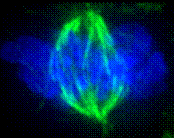mitotic spindle
A mitotic spindle is an array of microtubules and associated molecules
that forms between the two poles of a eukaryotic
cell during mitosis and serves to move the
duplicated chromosomes apart.
 |
| Chromosomes (blue) and the mitotic spindle (green)
during mitosis. Image: Oak Ridge National Laboratory
|
During the first stage of mitosis, prophase, the chromosomes condense and become visible as double strands (each strand being termed a chromatid) and the nuclear envelope breaks down. At the same time the mitotic spindle forms by the polymerization of microtubules and the chromosomes are attached to spindle fibres at their kinetochores. In metaphase the chromosomes align in a central plane perpendicular to the long axis of the spindle. This is termed the metaphase plate. During anaphase the paired chromatids are apparently pulled to opposite poles of the spindle by means of the spindle fibre microtubules attached to the kinetochore, though the actual mechanism for this movement is still controversial. This separation of chromatids is completed during telophase, when they can be regarded as chromosomes proper.


